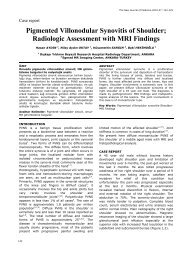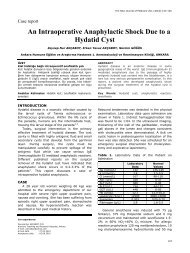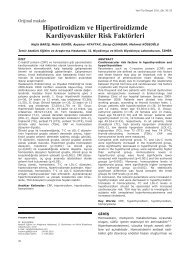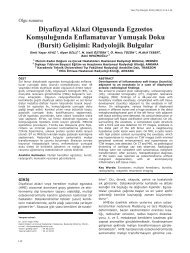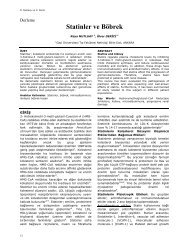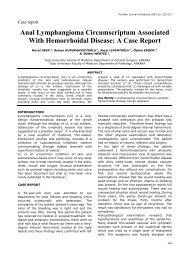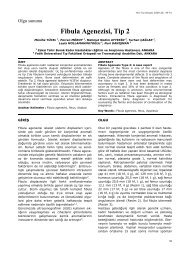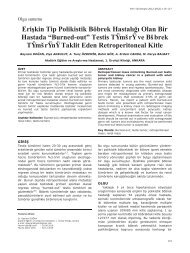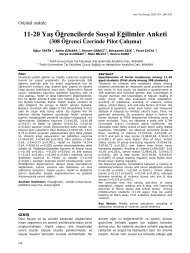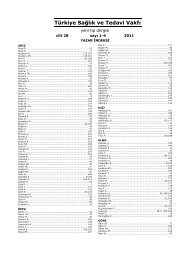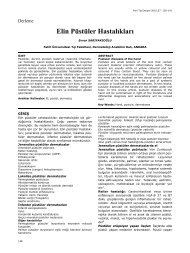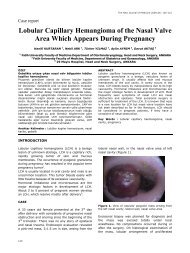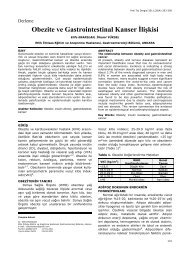Nitrofurantoin ve Fosfomisinin İdrar Yolu ... - Yeni Tıp Dergisi
Nitrofurantoin ve Fosfomisinin İdrar Yolu ... - Yeni Tıp Dergisi
Nitrofurantoin ve Fosfomisinin İdrar Yolu ... - Yeni Tıp Dergisi
You also want an ePaper? Increase the reach of your titles
YUMPU automatically turns print PDFs into web optimized ePapers that Google loves.
-78<br />
Orjinal makale<br />
<strong>Nitrofurantoin</strong> <strong>ve</strong> <strong>Fosfomisinin</strong> <strong>Yolu</strong><br />
Enfeksiyonu Etkeni Olan E. coli invitro<br />
<br />
1 ,Erkan YULA 2 , Vicdan KÖKSALDI MOTOR 3 ,Mürsel DAVARCI 1 , Nizami DURAN 2 ,<br />
Çetin KILINÇ 2 2<br />
1 Mustafa Kemal HATAY<br />
2 , HATAY<br />
3 <br />
, HATAY<br />
ÖZET<br />
Amaç <br />
mikroorganizma E. colifeksiyonu<br />
etkeni olan E. coli kökenlerinin nitrofurantoin,<br />
-<br />
in vitro -<br />
<br />
Materyal <strong>ve</strong> Metot E. coli<br />
laktamaz<br />
(GSBL) üretimi çift disk sinerji testi ile antibi-<br />
Kirby-Bauer disk difüzyon yöntemi ile<br />
Clinical and Laboratory Standards Institute<br />
<br />
Bulgular: 6, fosfomisine<br />
ise %91,biyotiklerden<br />
en yüksek sefepim <br />
<br />
GSBL üretimi, enfeksiyonun hastane ya da toplum kay-<br />
-<br />
<br />
Sonuç: <strong>Nitrofurantoin</strong> <strong>ve</strong> fosfomisinin üriner sistem<br />
<br />
<br />
Anahtar Kelimeler: Escherichia koli; idrar yolu enfeksiyonu;<br />
a<br />
ABSTRACT<br />
In-vitro efficiency of nitrofurantoin and fosfomycin<br />
against E. coli isolates in urinary tract infections<br />
Object: One of the most frequently isolated microorganisms<br />
urinary tract infections (UTI) is E. coli. In this<br />
study, we aimed to determine susceptibility of E. coli<br />
strains isolated from patients with UTI against<br />
nitrofurantoin, fosfomycin trometamol and some other<br />
frequently used antibiotics.<br />
Material and Method: Totally 140 E. coli strains were<br />
used in the study. Extended-spectrum beta-lactamase<br />
(ESBL) test was performed by double-disc synergy test<br />
and antibiotic susceptibility was determined by Kirby-<br />
Bauer disc diffusion method according to Clinical and<br />
Laboratory Standards Institute (CLSI) criteria.<br />
Results: It was found that 93.6% of the isolates were<br />
susceptible to nitrofurantoin whereas 91.4% of the<br />
isolates were susceptible to fosfomycin. Among the other<br />
antibiotics, susceptibility was highest to cefepime and<br />
ceftazidime and lowest to ampicillin. Regarding ESBL<br />
production of the isolates, there was no significant<br />
difference between hospital and community acquired<br />
infections, and fosfomycin and nitrofurantoin resistance.<br />
Conclusion: It was concluded that nitrofurantoin and<br />
fosfomycin could be preferred in the empiric treatment<br />
of UTI.<br />
Key Words: Escherichia coli, urinary tract infection;<br />
antibiotics susceptility test<br />
<br />
klinikte -<br />
Bu enfeksi-<br />
Escherichia coli’dir 1-3 .<br />
biyotikler kotri-<br />
<br />
giderek artan oranda direnç bildirilmektedir 4,5 .<br />
-laktamazlar (GSBL) gram<br />
negatif baE. coli <strong>ve</strong> Klebsiella<br />
türlerinde spektrumlu<br />
adresi:<br />
<br />
Mustafa Kemal Üni<strong>ve</strong>rs Hatay<br />
e-mail: mehmetinci@gmail.com<br />
: 03.09.2012<br />
: 25.09.2012<br />
dir<br />
6,7 .<br />
GSBL üreten bakterilerle meydana gelen enfek-<br />
<br />
8 .<br />
,<br />
yurdumuzda da <br />
fosfonik asit türevi olan fosfomisin trometamin E.<br />
coli <strong>ve</strong> Citrobacter %90’dan fazla,<br />
Enterobacter, Klebsiella pneumoniae, Klebsiella<br />
oxytoca, Proteus mirabilis, Staphylococcus aureus,<br />
Koagülaz negatif stafilokok <strong>ve</strong> enterokok izolatla-<br />
ise %70’den etkilidir 9 . A fosfomisin,<br />
iyi tolere edilebilen, yan etkileri az olan <strong>ve</strong><br />
<br />
kolay olüriner sistem antisepti 9,10 .<br />
75
-<br />
drar <br />
için spesifik olan bu antibakteriyel d trasyonlarda<br />
bakteriyostatik, yüksek konsantrasyonlarda<br />
bakterisidal etkilidir.<br />
<br />
direnç görülmemektedir. Bunun nedeni olarak<br />
ilemesi gösterilmektedir.<br />
E. coli <strong>ve</strong> e<br />
etkilidir 9 .<br />
da üriner sistem enfeksiyonu etkeni<br />
olan E. coli k fosfomisin trometamol,<br />
nitrofurantoin <strong>ve</strong> yotiklere<br />
n in-vitro olarak -<br />
amaçlan<br />
MATERYAL VE METOT<br />
idrar yolu enfeksiyonu etkeni olan<br />
140 E. coli izolat hil edildi. Hastalardan uygun<br />
idrar örnekleri eozin metilen<br />
mavisi agara ekildikten sonra 37C°’de 18-24 saat<br />
inkübe edildi <strong>ve</strong> süre sonunda 5 cfu/mL bakteri<br />
üreyen izolatlar .<br />
Kökenlerin konvansiyonel yöntemlerle<br />
-48 saatlik<br />
etimi<br />
çift disk sinerji testi ile ise<br />
Kirby-Bauer disk difüzyon yöntemi ile <strong>ve</strong><br />
Clinical and Laboratory Standards Institute (CLSI)<br />
11 .Olar<br />
dirençli kabul edildi.<br />
Antibiy nitrofurantoin<br />
(30 , fosfomisin trometamol (20 siprofloksasin<br />
(5 , seftriakson(3, sefotaksim (30<br />
, amoksisilin-klavulanik asit (30 , trimetoprim-sulfametoksazol<br />
(25 , ampisilin ,<br />
seftazidim (3, gentamisin <strong>ve</strong> sefepim<br />
(3 -<br />
E. coli ATCC 25922 kalite kontrol<br />
.<br />
Verilerin istatistiksel analizinde ki-kare testi<br />
<br />
BULGULAR<br />
140 izolat <br />
(%22,9) çocuk, 108’inin (%77, nin<br />
(%43,6) yatarak tedavi gören, 79’unun (%56,4)<br />
ise poliklinik hasta<br />
,<br />
105’inin (%75) ise toplum kökenli üriner sistem<br />
Kökenlerin<br />
9) GSBL , 80’inin (%57,1) ise<br />
GSBL <br />
anti-<br />
1’de göste<br />
Tablo 1. E. coli <br />
Antibakteriyeller n (%) n (%) Dirençli n (%)<br />
<strong>Nitrofurantoin</strong> 131 (93,6) 4 (2,9) 5 (3,5)<br />
Fosfomisin trometamol 128 (91,4) 3 (2,1) 9 (6,5)<br />
Seftazidim 96 (68,6) 5 (3,6) 39 (27,8)<br />
Sefepim 96 (68,6) 2 (1,4) 42 (30)<br />
Gentamisin 88 (62,9) 2 (1,4) 50 (35,7)<br />
Amoksisilin-klavulanik asit 82 (58,6) 6 (4,3) 51 (37,1)<br />
Seftriakson 80 (57,1) 1 (0,7) 61 (42,2)<br />
Sefotaksim 78 (55,7) 1 (0,7) 59 (43,6)<br />
Siprofloksasin 76 (54,3) - 64 (45,7)<br />
Trimetoprim- sulfametoksazol 65 (46,4) - 75 (53,6)<br />
Ampisilin 36 (25,7) 1 (0,7) 103 (73,6)<br />
Tablo 2. GSBL pozitif <strong>ve</strong> negatif E. coli <br />
Antibakteriyeller<br />
GSBL pozitif (n= 60) GSBL negatif (n= 80)<br />
Dirençli n (%) Dirençli n (%)<br />
<strong>Nitrofurantoin</strong> 54 (90) 6 (10) 77 (96,2) 3 (3,8)<br />
Fosfomisin trometamol 56 (93,3) 4 (6,7) 72 (90) 8 (10)<br />
Seftazidim 18 (30) 42 (70)* 78 (97,5) 2 (2,5)<br />
Sefepim 17 (28,3) 43 (71,7)* 79 (98,7) 1 (1,3)<br />
Gentamisin 18 (30) 42 (70)* 70 (87,5) 10 (12,5)<br />
Amoksisilin-klavulanik asit 23 (38,3) 37 (61,7)* 59 (73,7) 21 (26,3)<br />
Sefotaksim 3 (5) 57 (95)* 75 (93,7) 5 (6,3)<br />
Seftriakson 4 (6,7) 56 (93,3)* 76 (95) 4 (5)<br />
Siprofloksasin 15 (25) 45 (75)* 61 (76,2) 19 (23,8)<br />
Trimetoprim- sulfametoksazol 12 (20) 48 (80)* 53 (66,2) 27 (33,8)<br />
Ampisilin - 60 (100)* 36 (45) 44 (55)<br />
*p
Yatarak tedavi edilen hastalardan elde edilen izo-<br />
-<br />
larda<br />
025).<br />
Siprofloksasin, sefepim, trimetoprim-sulfametoksazol<br />
direnci yatan hastalarda daha yüksek<br />
p=0,001, p=0,017<br />
<br />
,05). Hastane kökenli enfeksiyonlardan<br />
elde edilen izolatlar ile toplum kökenliler<br />
<br />
,029).<br />
Antibiyotiklerden ise siprofloksasin, ampisilin,<br />
amoksisilin-klavulanik asit, trimetoprim-sulfametoksazol<br />
<strong>ve</strong> gentamisin direncinin hastane kökenli<br />
<br />
<br />
,05). GSBL pozitif <strong>ve</strong><br />
-<br />
<br />
a -<br />
-<br />
<br />
<br />
Üriner <br />
antibiyotiklere diren, -<br />
bu enfeksiyonlardan sorumlu mikroorganiz-<br />
, tedavide zorluklara yol<br />
tedavide yeni seçenekleri gündeme getir-<br />
2,5 . Uygun antibiyotik seçimine karar <strong>ve</strong>rebilmek<br />
için bölgesel antibiyotik direnç durum-<br />
bilinmesi .<br />
Literatürde idrar örneklerinden soyutlanan E.<br />
coli çantibiyotiklerin vitro<br />
tur.<br />
Brezilya, Rusya, Avusturya, Fransa, Almanya,<br />
Macaristan, Polon da’dan<br />
<br />
E.<br />
coli %98,1’lik oranla en yüksek fosfomisine,<br />
%45,1’lik oranla <br />
<br />
fosfomisin <strong>ve</strong> nitrofurantoin <br />
izolatlarda<br />
siprofloksasin için %91,8, amoksisilin-klavulanat<br />
için %82,1, trimetoprim-sulfametoksazol için %70,5<br />
12 .<br />
Kahlmeter <strong>ve</strong> Poulsen 5 Avrupa ülkesinin<br />
da <br />
idrar örneklerinden soyutlanan 908 E. coli izola-<br />
fosfomisin için %1,2, nitrofurantoin için %0,3<br />
larken, ampisilin, trimetoprimsulfametoksazol,<br />
amoksisilin-klavulanat, siprofloksasin,<br />
gentamisin, sefotaksim <strong>ve</strong> seftazidime <br />
1, %4,5, %3,9, %1,3, %1,2,<br />
%0,9 <br />
<br />
ile deki oranlar -<br />
<br />
<br />
. ECO.SENS I <br />
GSBL üreten izolata rastlanmazken, ECO.SENS II<br />
belirtir.<br />
toplum kökenli üriner sistem enfek-<br />
soyutlanan 164 E. coli <br />
fosfomisin <strong>ve</strong> nitrofurantoine <br />
bildiril 13 .<br />
<br />
Köken <strong>ve</strong> ark. 14 k lardan<br />
izole edilen 169 üriner E. coli nda<br />
fosfomisin trometamol için %0.6, siprofloksasin<br />
için %34.9, trimetoprim-sulfametoksazol için %58<br />
’ 15<br />
236 klinik üriner E. coli -<br />
fosfomisin için %97,<br />
amikasin için %99, sefepim için %87, seftriakson<br />
için %81, amoksisilin/klavulanik asit için %67,<br />
siprofloksasin için %63, trimetoprim/sulfametoksazol<br />
için %62, ampisilin için %32 olarak bulunmu<br />
rencin<br />
b cuttur<br />
16-19 .<br />
–Motor <strong>ve</strong> ark. 20 98 üropatojen E. coli<br />
<br />
, a<br />
%67, amoksisilin/klavulanik asite %35, trimetoprim/sulfametoksazole<br />
%39, siprofloksasine %62,<br />
gentamisine %<br />
Poliklinik <strong>ve</strong> servis hastalardan <br />
furantoin direnci<br />
%11,8 olarak b 21 . Tekin <strong>ve</strong> ark. 22 idrardan<br />
izole edilen 3279 E. coli <br />
talarda<br />
%89,2, ayaktan tedavi edilen hastalarda<br />
%93, <br />
<br />
Arslan <strong>ve</strong> ark.’ 2 <br />
olmayan üriner enfeksiyonlardan soyutlanan 228<br />
E. coli fosfomisin direnci %0,3, nitrofu-<br />
<br />
izole edilen 120 E. coli -<br />
fosfomisine %99,2, nitrofurantoine<br />
%90, sefotaksime %79,1, amoksisilinklavulanik<br />
asite %48,3, trimetoprim-sulfametoksazole<br />
%49,1, sefepime %79,1, siprofloksasine<br />
%55,8, ampisiline %31,6, gentamisine %80,8<br />
olarak belirti 23 . Poliklinikten <strong>ve</strong> yatan hasta-<br />
E. coli<br />
kökeni <br />
nurken, nitrofurantoine<br />
77
%97, ampisiline % 29, norfloksasine % 67, ampisilin-sulbaktama<br />
%52, trimetoprim-sulfametoksa-<br />
iltir 24 . Bizim<br />
amoksisilin/klavulanik asit,<br />
trimetoprim-sulfametoksazol <strong>ve</strong> nitrofurantoin<br />
ülkemizdeki nurken,<br />
-tibiyotiklerin du <br />
<br />
25 80 GSBL pozitif E. coli <br />
birinin fosfomisine dirençli <br />
direncin %66, trimetoprim-sulfametoksazol<br />
16 fosfomisin du -<br />
GSBL pozitif <br />
fark bulamazken; gentamisin, nitrofurantoin,<br />
amoksisilin-klavulanik asit, trimetoprimsulfametoksazol,<br />
ampisilin <strong>ve</strong> levofloksasine <br />
GSBL pozitif olan izolatlarda daha fazla direncin<br />
<strong>ve</strong> ark. 26 GSBL<br />
negatiflerde fosfomisin direnci saptamazken, pozitiflerin<br />
%2’sinde direnç . <br />
da <br />
tir<br />
21,22 . Bizim -<br />
<br />
<br />
<br />
<br />
direnç -<br />
<br />
Pullukçu <strong>ve</strong> ark. 21 yatan hastalardan soyutlanan<br />
kökenlerde nitrofurantoin direncini poliklinik<br />
<br />
bul Bizim <br />
k yatan hastalardan elde edilen izolatlarda<br />
siprofloksasin, sefepim <strong>ve</strong> trimetoprimsulfametoksazol<br />
direnci daha fazla bulunurken,<br />
nitrofurantoin <br />
<br />
Sonuç olarak; E. coli n<br />
ampirik tedavisinde fosfomisin <strong>ve</strong> nitrofurantoinin<br />
<br />
REFERANSLAR<br />
1. In: Willke Topçu A,<br />
, editors. <br />
Mikrobiyolojisi. 2008. s.1487-1506.<br />
2. Arslan H, Azap OK, Ergonul O, Timurkaynak F. Urinary Tract<br />
Infection Study Group: Risk factors for ciprofloxacin resistance among<br />
Escherichia coli strains isolated from community-acquired urinary tract<br />
infections in Turkey. J Antimicrob Chemother 2005;56(5):914-8.<br />
3. Keskin SK, Tokuç<br />
R. Son d risinde idrar kültürlerinden iz <br />
ge . Türk Üroloji <strong>Dergisi</strong> 2009;35(3):<br />
201-9.<br />
4. Sobel JD, Kaye D. Urinary tract infections. In: Mandell GL, Bennett<br />
JE, Dolin R, editors. 5th ed. Principles and Practice of Infectious Disease.<br />
Churcill Livingstone: Philadelphia; 2000. p.773-800.<br />
5. Kahlmeter G, Poulsen HO. Antimicrobial susceptibility of<br />
Escherichia coli from community-acquired urinary tract infections in Europe:<br />
the ECO·SENS study revisited. Int J Antimicrob Agents 2012;39(1):45-51.<br />
6. Sanders CC, Sanders WE. Beta-lactam resistance in gram negati<strong>ve</strong><br />
bacteria; Global trends and clinical impact. Clin Infect Dis 1992;15(5):824-<br />
83.<br />
7. Steward CD, Rasheed JK, Hubert SK, Biddle JW, Raney PM,<br />
Anderson GJ, et al. Characterization of clinical isolates of Klebsiella<br />
pneumoniae from 19 laboratories using the National committee for clinical<br />
laboratory standards extended-spectrum–lactamase detection methods.<br />
JCM 2001;39(8):2864-72.<br />
8. Procop GW, Tuohy MJ, Wilson DA, Williams D, Hadziyannis E, Hall<br />
GS. Cross-class resistance to non betalactam antimicrobials in extended<br />
spectrum beta-lactamase producing Klebsiella pneumoniae. Am J Clin<br />
Pathol 2003;120(2):265-67.<br />
9. istem antiseptikleri. In: Willke-Topçu A, Söyletir<br />
, editors.<br />
2008. s.377-87.<br />
10. Falagas ME, Giannapoulou KP, Kokolakis GN, Rafailidis PI.<br />
Fosfomycin: Use beyond uninary tract and gastrointestinal infections. Clin<br />
Infect Dis 2008;46(7):1069-77.<br />
11. Clinical and Laboratory Standarts Institute. Performance Standarts<br />
for Antimicrobial Susceptibility Testing; Tweenty-First Informational<br />
Supplement. CLSI document (M100-S21), CLSI, Wayne PA (2011).<br />
12. Naber KG, Schito G, Botto H, Palou J, Mazzei T. Sur<strong>ve</strong>illance study<br />
in Europe and Brazil on clinical aspects and Antimicrobial Resistance<br />
Epidemiology in Females with Cystitis (ARESC): implications for empiric<br />
therapy. Eur Urol 2008;54(5):1164-75.<br />
13. Alós JI, Serrano MG, Gómez-Garcés JL, Perianes J. Antibiotic<br />
resistance of Escherichia coli from community-acquired urinary tract<br />
infections in relation to demographic and clinical data. Clin Microbiol Infect<br />
2005;11(3):199-203.<br />
14. <br />
<br />
-7.<br />
15. . In-vitro susceptibility of<br />
clinical isolates of Escherichia coli to fosfomycin trometamol and other<br />
antibiotics. ANKEM Derg 2005;19(2):77-9.<br />
16. <br />
-Vitro<br />
-102.<br />
17. De<strong>ve</strong>ci Ö, Yula E, Toka-Özer T, Tekin A. Üriner sistem<br />
Escherichia coli <br />
trometamolün - <br />
2011;38(3):298-300.<br />
18. <br />
<strong>Yolu</strong> infeksiyonu Etkeni Olan Escherichia coli <br />
<br />
Derg 2008;22(2):81-4.<br />
19. <br />
<br />
-KEM Derg 2009;<br />
23(4):172-6.<br />
20. -<br />
Escherichia coli <br />
<br />
198-201.<br />
21. Pull<br />
<strong>Nitrofurantoin</strong>in idrar kültürlerinden soyutlanan Escherichia coli in<br />
vitro -200.<br />
22. n Vitro<br />
Escherichia coli Strains<br />
Isolated from Urine Cultures. The New Journal of Medicine 2012;29(2):88-<br />
91.<br />
23. Aykut Arca E, Karabiber N. Short communication: comparison of<br />
susceptibilities of Escherichia coli urinary tract isolates against fosfomycin<br />
tromethamine and different antibiotics. Mikrobiyol Bul 2007;41(1):115-9.<br />
24. <br />
Escherichia coli, Klebsiella <strong>ve</strong> Enterokok cinsi bakterilerde fosfomisin<br />
-22.<br />
25. <br />
Activity of Fosfomycin Against Extended Spectrum--Lactamase (ESBL)<br />
Producing Escherichia coli and Klebsiella pneumoniae Strains. Turk J<br />
Immunol 2008;13:1-4.<br />
26. , Ozyurt M, Baylan O, Bektöre B, Ardiç N, Ceylan S, et al.<br />
In vitro activity of fosfomycin trometamol in the treatment of Escherichia<br />
coli related uncomplicated urinary tract infections. Mikrobiyol Bul 2009;43<br />
(4):645-9.<br />
78



